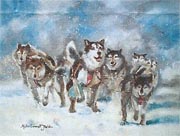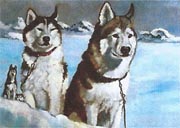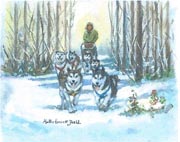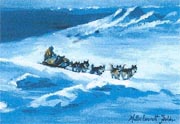SLED DOG RACING ….
The Heritage of the sled dog is a long and proud one, stretching some 4,000 years. The people of the North were dependent on these animals for protection, companionship, hunting, trapping and most of all – transportation. Sled dogs have enabled explorers such as Byrd, Peary and Amundsen to travel the frozen wastelands of two Poles and have played a vital role in bringing civilisation to the snowbound areas of the world.
They have helped men in two World Wars and, of course, the Canadian Mountie owes much of his fame to his team of dogs. One of the proudest chapters in sled dog history was written in 1925. In January of that year a case of diphtheria was discovered in Nome, Alaska but the supply of antitoxin in that city was inadequate to stave off an epidemic. A relay of 22 native and mail teams and their drivers forged through the rough interior of Alaska and across the Bering Sea ice to bring the serum from Anchorage to the grateful townspeople. A statue of Balto, who led one of the relay teams, stands in New York’s Central Park to commemorate this Nome Serum Run. The IDITAROD TRAIL RACE started in the 1970’s by Joe Redington Senior and other keen team drivers, held during March of each year in the memory of this Serum Run, which covers 1,049 miles across some of the worst terrain in the world. A number of Britons have competed in this race, though as yet none have been placed. Every year this race attracts more and more worldwide interest, as does the sport of sled dog racing as a whole.
The first sled race probably occurred when two trappers challenged each other’s tams and dashed their dogs over the ice fields of the Frozen North. The records of formal racing date back to 1908 with the first running of the ALL ALASKA SWEEPSTAKES under the rules of the Nome Kennel Club. This race was inspired by two children quarrelling over their dogs’ prowess and their father, Scotty Allen, a Scot heralding from the Spey Valley in the Highlands of Scotland, deciding that a race would settle matters. This had spiralled into a 408 mile race from Nome to Candle and back.
In 1908 the winning driver, John Hegness, completed in a time of 119 hours, 15 mins, 12 secs. By 1910 entries had increased considerably as had the speed of the teams. The winners of that race were John (Iron Man) Johnson and second was Charles Fox Maule Ramsay – another Scot and younger son of the Earl of Dalhousie. Both were driving teams of Siberian Huskies. John Johnson’s time of 74 hours, 14 mins and 37 secs remained until the centenary anniversary run of the Sweepstakes in 2008 (won by Mitch Seavey) was broken by the first six teams. The Siberian Husky Club of Great Britain is extremely lucky to hold the original trophy from this 1910 race – found in an attic in Scotland in the 1980’s by the late Lady Anne Jardine of Applegirth – a relation of Charles Fox Maule Ramsey. Currently the trophy resides on loan in the Carrie M. McLain Memorial Museum in Nome alongside trophies from the early 20th century All Alaska Sweepstakes and the 75th anniversary run trophy won by Rick Swenson.
Enthusiasm for sled dog racing spread rapidly throughout North America with only a brief interruption during the periods of two World Wars, when dogs and drivers were taken into the service of their countries.
These days few of the inhabitants of the far North are dependent upon dogs for basic survival, however, the same intimate relationship between man and dog still exists and is evidenced through our sport, which has now emerged into a major worldwide interest with teams working throughout North America, Europe and even as far as Australia and New Zealand. The Siberian Husky Club of Great Britain’s Aviemore Sled Dog Race is the longest running and largest event of its kind in the UK, attracting over 200 teams each year. Effort continues towards sled dog racing being included as a Winter Olympic Event – how far we have come since the Gold Rush at the turn of the 20th century !
Racing sled dogs are amongst the best-cared for animals in the world. The sport is based on athletic performance and, therefore, diet and physical fitness is always of the upmost importance. Many huskies in Great Britain are fed on proprietary branded complete diets for working/sporting dogs, sometimes with the addition of extra meat and even fruit, and of course, the BARF (Bones-and-Raw-Food) diet is more than suitable for sled dogs. Biscuit is usually kept to a minimum with importance being placed on protein and fat content rather than carbohydrate – although a biscuit to ‘go to bed’ is always an acceptable extra.
Training, of course, plays an important part, although finding suitable trails in Britain will always remain an enthusiast’s greatest problem. The Siberian Husky Club of Great Britain, however, is always striving to find suitable trails to add to its annual rally calendar that will challenge its ever-keen competitors and teams.
Sled dog racing is a sport where men and women can compete as true equals and can provide your family with a unique and exciting entertainment, whether as competitors or spectators. As a growing sport, numbers are increasing and there is a thriving Junior Competition each year with Cani-Cross and Ski-Joring events (where just one dog can their human can compete) are often run alongside the race events.
Training of young dogs starts at an early age over short distances. With age and experience distances increase until the youngster reaches one year old when they are allowed to compete in races. Training has to be undertaken very carefully – at all times the welfare and more particularly the enjoyment of the dogs is of primary importance. A bored team member is not only an unhappy dog, but affects the performance of the whole team. Regular training, sometimes four times a week in the Winter Season is required for competitive teams. A new team and its musher will always benefit from training with a more experienced kennel.
Design of racing sleds have changed little from those used in the early days, though modern technical materials have in the main taken over from traditional wood. The same cannot be said of the wheeled rigs which are used more often in Britain due to our temperate climate. Personal taste is of great importance with design altering radically over the years – changing in weight from around 50 kg for a 4-dog team to only some 15 kgs., mild and stainless steel being the preferred materials. The SHCGB has devised a set of Working Rally Rules that stress the importance of safety to both team and driver. All SHCGB Rallies are held under these Rules.
Each dog in the team wears an individually-fitted harness generally of lightweight nylon/polypropylene webbing, padded around the neck and shoulders for comfort. Again there are a number of designs giving good choice for suitability and personal preference. The dogs are hitched to the rig or sled by means of a central rope known as the ‘gang line’ being attached to this by means of a tug line to the rear of the harness and a neckline from the dog’s collar. Brass clips – that do not rust or freeze – are used to attach the dog into the lines. Other equipment includes the snub line – used to secure teams at the start and out on the trail – and a dog bag, which is used to carry an injured or tired dog, and a shock absorber to regulate the pull to the rig.
British sled dog races are generally held on a ‘looped’ course over forest or similar trails with each team released at timed intervals. In races of more than one heat, total elapsed time is taken to determine the winner. Larger races may enjoy the added bonus of electronic timing. Teams are divided into classes based on the number of dogs in the team:
A No more than 8 dogs, no less than 5 B No more than 6 dogs, no less than 4
C No more than 4 dogs, no less than 3 D 2 dogs only
E No more than 3 dogs, no less than 2 U Unlimited, no less than 5 dogs
Junior 1 1 dog (dog 1 year+ / driver 12-15)
Junior 2 1-2 dogs (dog 1 year+ / driver 8-11)
Cani-Cross – one dog and a competitor, racing on foot
Bike-Joring – one dog and a driver pedalling on a bicycle
Scooter – one dog and a driver riding a two-wheeled scooter
Where numbers allow a .2 Class may be scheduled which offers mixed sled dog pedigree breeds, ie., Alaskan Malamute, Canadian Eskimo Dog, Greenland Dog and Samoyeds, a separate class from the generally faster all Siberian Breed Teams, ie., C.2, D.2 etc.
There is no spectacle like a sled dog race, so why not come along to watch? Volunteers to help out are always welcome …. see details of the SIBERIAN HUSKY CLUB OF GREAT BRITAIN’S annual rally calendar on this website.














Social Links